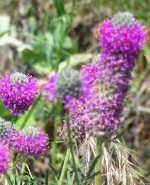 Purple praire clover is a herbaceous perennial and a member of the pea family, Fabaceae, that also includes lupines, mimosa, and black locust. It is native to central North America from Ontario to Georgia west to Alberta and Arizona where it grows in prairies, savannas, and open woods. Plants grow 1-3″ tall and have multiple stems and pinnately compound dark green leaves with 3-7 narrow leaflets about 1″ long. The small purple flowers are produced on 1-2” cone-like spikes and are accented by golden anthers that extend beyond the petals. The flowers begin to open at the bottom of the cone and form a wreath that gradually moves upward. The result is a long bloom period that extends from mid-summer into fall. The flowers attract bees and the plant is a host plant for sulfur butterfly larva. The plant is anchored by a large taproot making it drought tolerant but difficult to transplant. Like other plants in the legume family, purple prairie clover fixes nitrogen in the soil and is valuable in re-vegetation and prairie restoration. It is high in protein and is excellent forage for livestock and wildlife. The genus name, Dalea, honors Samuel Dale, a 17th-18th century English Botanist. The specific epithet, purpurea, comes from the Latin word purpureus meaning purple, and refers to the color of the flowers.
Purple praire clover is a herbaceous perennial and a member of the pea family, Fabaceae, that also includes lupines, mimosa, and black locust. It is native to central North America from Ontario to Georgia west to Alberta and Arizona where it grows in prairies, savannas, and open woods. Plants grow 1-3″ tall and have multiple stems and pinnately compound dark green leaves with 3-7 narrow leaflets about 1″ long. The small purple flowers are produced on 1-2” cone-like spikes and are accented by golden anthers that extend beyond the petals. The flowers begin to open at the bottom of the cone and form a wreath that gradually moves upward. The result is a long bloom period that extends from mid-summer into fall. The flowers attract bees and the plant is a host plant for sulfur butterfly larva. The plant is anchored by a large taproot making it drought tolerant but difficult to transplant. Like other plants in the legume family, purple prairie clover fixes nitrogen in the soil and is valuable in re-vegetation and prairie restoration. It is high in protein and is excellent forage for livestock and wildlife. The genus name, Dalea, honors Samuel Dale, a 17th-18th century English Botanist. The specific epithet, purpurea, comes from the Latin word purpureus meaning purple, and refers to the color of the flowers.
Type: Herbaceous perennial
Bloom: Small purple flowers with orange stamens are produced on spikes at the top of wiry stems from mid summer to fall.
Foliage: Pinnately compound leaves are dark green and are fine textured.
Size: 12-24” H x 12-18” W
Light: Full sun; tolerates some shade
Soil: Humus rich, average-dry, well-drained, neutral to slightly alkaline
Fertilizer: Needs no nitrogen; apply phosphorus and potassium if soil is deficient in these nutrients.
Hardiness: Zones 3-8
Care: Low maintenance
Pests and Diseases: None of significance
Propagation: Seeds (scarify with sandpaper); does not transplant well.
Companion plants: White prairie clover (Dalea candida), pale purple coneflower (Echinacea pallida), whorled milkweed (Asclepias verticillata), nodding wild onion (Allium cernuum), and culver’s root (Veronicastrum virginicum).
